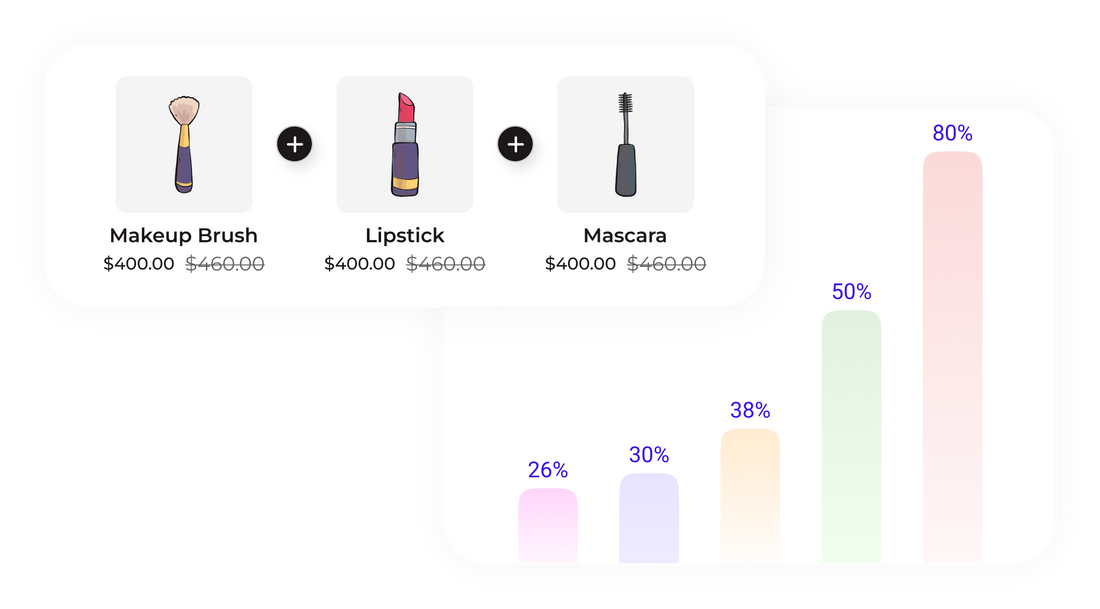Why Product Bundles Matter for Shopify Growth

In the fast-moving world of e-commerce, simply listing products on your Shopify store isn’t enough to capture and retain customers. Today’s shoppers want more than a transaction — they expect value, personalization, and convenience.
One of the most effective ways to meet these expectations (while boosting your own revenue) is through product bundling.
For Shopify merchants, bundling is more than just a sales tactic — it’s a growth strategy that increases average order value (AOV), builds loyalty, and creates win-win deals for both you and your customers.
What Are Product Bundles?
Product bundling means selling multiple products together in a single package, often at a discounted price compared to buying each item separately.
Bundles can be simple, like pairing two related items, or strategic, like letting customers build their own selection.
Why Product Bundles Work for Shopify Stores
- Boost Average Order Value (AOV): Customers spend more when they see better perceived value in buying together.
- Reduce Decision Fatigue: Ready-to-buy sets make purchasing easier and faster.
- Clear Slow-Moving Inventory: Pair popular items with slow sellers.
- Increase Repeat Purchases: Well-thought-out bundles encourage loyalty.
- Higher Profit Margins: Marketing multiple items in one sale lowers acquisition costs per product.
11 Powerful Bundle Types for Shopify and Their Benefits
1. Product Bundle
What it is: A set of related products sold together at a discounted price.
Example: “Winter Essentials Set” — gloves, scarf, and beanie.
Benefits:
- Makes it easier for customers to get everything they need in one purchase.
- Encourages shoppers to discover and try more of your products.
- Increases total cart value without pushing unnecessary items.
2. Volume Discount
What it is: The more a customer buys, the bigger the discount.
Example: Buy 2 for 10% off, Buy 3 for 15% off.
Benefits:
- Encourages bulk purchasing.
- Helps clear large amounts of stock quickly.
- Attracts cost-conscious customers who value savings.
3. Combo Offer
What it is: Pairing different, related products for one attractive price.
Example: Laptop + Laptop Bag.
Benefits:
- Creates logical pairings that feel natural to buy together.
- Improves the customer experience by offering convenience.
- Highlights product compatibility, boosting cross-category sales.
4. Popup Bundle
What it is: A bundle offer displayed in a popup when customers perform certain actions — such as adding an item to the cart, visiting a product page, or intending to exit the store.
Example: Adding a shampoo to cart triggers a popup offering a shampoo + conditioner + comb set at 20% off.
Benefits:
- Captures attention at the perfect buying moment.
- Increases bundle adoption by making offers hard to miss.
- Reduces cart abandonment by providing an irresistible deal before checkout.
- Highly customizable based on user behavior (e.g., location, cart value, products viewed).
5. Add-ons
What it is: Offering smaller, relevant products during checkout.
Example: Buying a phone? Add a screen protector for $5.
Benefits:
- Low-cost upsell opportunity that feels helpful, not pushy.
- Increases order value without much extra effort.
- Promotes products customers might have forgotten to buy.
6. Cross-Sell
What it is: Suggesting related items based on the current purchase.
Example: Buying a camera? Suggest a tripod.
Benefits:
- Introduces customers to other product categories.
- Boosts discovery of items they didn’t know they needed.
- Enhances customer satisfaction by offering complete solutions.
7. Upsell
What it is: Encouraging customers to upgrade to a better, more expensive version.
Example: Buying a basic coffee machine? Offer the deluxe model with extra features.
Benefits:
- Raises the average transaction value significantly.
- Position your brand as premium by highlighting higher-quality options.
- Improves perceived value through added features.
8. Post-Purchase
What it is: Offering additional products after checkout, often at a limited-time discount.
Example: “Thanks for your order! Get 20% off a matching wallet within 15 minutes.”
Benefits:
- Creates revenue opportunities after the initial sale.
- Increases customer excitement right after purchase.
- No disruption to the original checkout flow.
9. Frequently Bought Together
What it is: Displaying products that are often purchased together on a product page.
Example: Printer + Ink + Paper.
Benefits:
- Builds trust by showing popular buying patterns.
- Makes shopping more convenient for the customer.
- Improves multi-item order rates.
10. Build a Box
What it is: Customers choose their own bundle from a range of products.
Example: Pick 6 snacks for your monthly subscription box.
Benefits:
- Gives customers control and personalization.
- Encourages higher spending through flexible quantity options.
- Works great for subscription or recurring orders.
11. Smart URL
What it is: A single link that pre-loads a customer’s cart with bundled products.
Example: Clicking a “Buy the Summer Set Now” link takes them directly to checkout with all items pre-selected.
Benefits:
- Reduces friction in the buying process.
- Perfect for email marketing and social media campaigns.
- Increases conversion rates by skipping extra steps.
How to Implement Bundles in Your Shopify Store
- Use a bundling app like Rebolt – Product Bundles to set up multiple bundle types easily.
- Show clear savings and highlight benefits visually on product pages.
- Test different bundles and track AOV, conversion rates, and sell-through.
- Promote bundles across your homepage, product pages, email newsletters, and paid ads.
The Bottom Line
Product bundles are not just about discounts — they are a strategic tool to grow your Shopify store. Whether you use Volume Discounts to move stock, Build a Box to engage customers with personalization, or Post-Purchase Offers to squeeze more value from each order, bundling can dramatically impact your sales.
Start with one or two bundle types, measure results, and expand your strategy as you see what works best for your audience.
